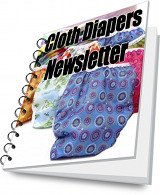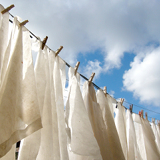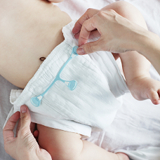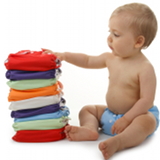Washing Cloth Diapers
How to Wash Cloth Diapers
Everyone has their own strategy for washing cloth diapers. The tips for washing cloth diapers below outline strategies that work for me as well as some strategies that I don't use myself, but other cloth diapering parents have used with success.
The approach that works best for you for cleaning cloth diapers will depend on your laundry setup, the type of cloth diapers you are using, the nature of your baby's bowel movements, and your personal preferences.
Once you have changed your baby's diaper, if it is soiled, you will shake as much of the solids as possible into the toilet. How you choose to deal with the cloth diaper after this step is a matter of personal preference.
Rinsing or Not Rinsing
Parents have different preferences for dealing with soilds immediately after a diaper change. You may choose to rinse your diapers, or not rinse them, and within those two options, there are several ways to handle the soiled diaper. For details on cleaning cloth diapers immediately after a diaper change, please see the article Cleaning Cloth Diapers.
Wet Pail or Dry Pail
Whatever type of diaper pail you use, I like to store and wash my diaper covers separate from my soakers (assuming you use a two part diapering system such as prefold cloth diapers). I store my diaper covers in a lingerie bag. It's just the right size, and it provides an easy solution for keeping my diaper covers separate from everything else.
Your routine for washing cloth diapers will be affected by whether you choose to store wet and soiled diapers in a wet pail or a dry diaper pail between washings.
Dry Cloth Diaper Pail
Using a dry pail is an extremely easy way to store cloth diapers. Simply deal with soiled diapers using your method of choice for cleaning cloth diapers after a diaper change and then toss the diaper into a diaper pail.
I use a diaper pail liner in my dry diaper pail just to avoid the need to scrub the pail on a regular basis. If you use a washable diaper pail liner, keep in mind that you'll need two liners so you'll have an extra when one is in the wash.
My diaper pail has a well fitting lid, and a carbon filter, which goes a long way to keep odor in the pail and out of my baby's room.
You may use a dry diaper pail to store either non-rinsed diapers or rinsed diapers that you have wrung out; however, if you store damp, rinsed diapers in a dry pail, you absolutely must wash your diapers every couple of days or you run the risk of getting mold and mildew on your cloth diapers.
Wet Cloth Diaper Pail
Using a wet diaper pail allows you to pre-soak the diapers before you wash them and can help reduce stains.
To use the wet diaper pail method of storing your cloth diapers, fill your diaper pail to about half full with water. You may also choose to add some vinegar, detergent, baking soda, borax or a couple of drops of tea tree oil. After each diaper change, follow your method of choice for dealing with soiled diapers, then place the diaper in your wet diaper pail.
A couple of considerations to keep in mind if you are deciding whether to use a wet diaper pail:
-
A diaper pail full of water and diapers can be quite heavy to carry to your laundry area on wash day. Consider storing the diaper pail near your laundry area if this option is feasible based on your current laundry setup.
- Wet diaper pails are a drowning hazard for children, so ensure your wet pail has a secure, lockable lid and that you make a point of locking the lid consistently.
Washing Cloth Diapers
Once it's time to wash your cloth diapers, your approach will vary depending on whether you use a wet pail or a dry pail. It is important to wash your cloth diapers in hot water, and to ensure no residue is left on the diaper (residue can cause your diapers to become less absorbent).
How to Wash Cloth Diapers-
If your diapers were stored in a wet pail, dump the diapers and the soak water in the machine and run a spin cycle.
-
If your diapers were stored in a dry pail, run a cold cycle with Borax, washing soda or baking soda.
-
Wash your diapers on a hot cycle using the detergent recommended by the diaper manufacturer, or a detergent that does not contain fabric softener.
- Following up with a cold rinse can help prevent residue buildup and maintain your diapers' absorbency.
For more detailed information about washing cloth diapers, please see the article How to Wash Cloth Diapers
Stripping Cloth Diapers
From time to time you may find that residue from your laundry detergent has built up on your cloth diapers. Residue build up can cause problems such as reduced absorbency, diaper rashes (if your baby is sensitive to the detergent you use) and odor. Stripping cloth diapers is simple to do, and it can resolve these issues.
Natural Laundry Detergent
The type of laundry detergent you use to wash your cloth diapers can have a big impact on the absorbency of your diapers.
Some parents swear by soap nuts for cleaning cloth diapers. Soap nuts, also known as soap berries, are the fruit of the sapindus mukorossithe tree. They contain saponin, which is released when the shells come in contact with warm or hot water. They are all natural, don't contain any synthetic chemicals, are gentle on sensitive skin and do not leave residue on clothing (an important consideration for washing cloth diapers because, as noted above, residue can significantly reduce absorbency).
After experimenting with soap berries for a few months, I've come up with a review of the pros and cons of using soap nuts as well as instructions on how to use soapnuts.
General Tips on Washing Cloth Diapers
-
Wash your cloth diapers frequently. Every 2 or 3 days is ideal.
-
New diapers must be washed several times to reach full absorbency. If you use new cloth diapers without washing them several times, you will likely experience leaks.
-
Always check the washing instructions on your diapers carefully before washing them for the first time. Some fabrics have special requirements that you will need to follow.
- Fold your clean, dry diapers any way you like. My prefolds are folded in thirds so they don't require much folding when I need to change a diaper. Other parents prefer to fold their diapers (or assemble them if you're using pocket diapers or AI2 diapers) as they go and just store their diapers unfolded.
Like Cloth-Diapers-Online.com?









New! Comments
Have your say about what you just read! Leave me a comment in the box below.